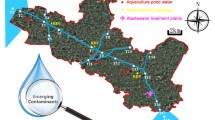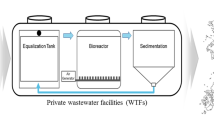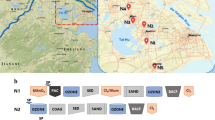Abstract
The present study investigated the occurrence of 29 selected micropollutants such as endocrine disrupting compounds (EDCs) and pharmaceuticals and personal care products (PPCPs) in surface waters and wastewaters in Seoul (South Korea) during both dry and wet weather conditions. The study area was selected based on the lack of available information regarding the suspected contamination of rivers/creeks by EDCs and PPCPs in the Seoul region and the presence of a wastewater treatment plant (WWTP), which serves approximately 4.1 million inhabitants and has a design capacity of 1,297 × 103 m3/day. Many target compounds (83 %) were detected in samples collected from wastewater treatment influent/effluent, creek water, and combined sewer overflow (CSO). The total EDC/PPCP concentrations were as follows: WWTP influent (69,903 ng/L) > WWTP effluent (50,175 ng/L) >3 creek samples (16,035–44,446 ng/L) during dry weather, and WWTP influent (53,795 ng/L) > WWTP bypass (38,653 ng/L) >5 creek samples (15,260–29,113 ng/L) >2 CSO samples (11,109–11,498 ng/L) during wet weather. EDCs and PPCPs were found to be present at high daily loads (65.1 and 69.8 kg/day during dry and wet weather, respectively) in the WWTP effluent. Compound removal by the WWTP varied significantly by compound: caffeine, diclofenac, ibuprofen, naproxen, and propylparaben (>90 %), and acesulfame, DEET, iohexol, iopromide, and iopamidol (<5 %). These findings and literature information support the hypothesis that the efficiency of removal of EDCs and PPCPs is strongly dependent on both removal mechanism (e.g., biodegradation, adsorption to sludge, and oxidation by chlorine) and compound physicochemical properties (e.g., pK a and hydrophobicity).



Similar content being viewed by others
References
Alexy, R., Kumpel, T., & Kummerer, K. (2004). Assessment of degradation of 18 antibiotics in the Closed Bottle Test. Chemosphere, 576(6), 505–512.
Alp, E., Melching, C. S., Zhang, H., & Lanyon, R. (2007). Effectiveness of combined sewer overflow treatment for dissolved oxygen improvement in the Chicago Waterways. Water Science and Technology, 56(1), 215–222.
Al-Rajab, A. J., Sabourin, L., Scott, A., Lapen, D. R., & Topp, E. (2009). Impact of biosolids on the persistence and dissipation pathways of triclosan and triclocarban in an agricultural soil. Science of the Total Environment, 407, 5978–5985.
Anumol, T., Merel, S., Clarke, B. O., & Snyder, S. A. (2013). Ultra high performance liquid chromatography tandem mass spectrometry for rapid analysis of trace organic contaminants in water. Chemical Central Journal, 7, 104–129.
APHA-AWWA-WPCP. (1998). Standard methods for the examination of water and wastewater (20th ed.). Washington D.C: American Public Health Association.
Benotti, M. J., & Brownawell, B. J. (2007). Distributions of pharmaceuticals in an urban estuary during both dry- and wet-weather conditions. Environmental Science & Technology, 41(16), 5795–5802.
Bester, K., & Schafer, D. (2009). Activated soil filters (bio filters) for the elimination of xenobiotics (micro-pollutants) from storm- and waste waters. Water Research, 43(10), 2639–2646.
Blair, B. D., Crago, J. P., Hedman, C. J., Treguer, R. J. F., Magruder, C., & Royer, L. S. (2013). Evaluation of a model for the removal of pharmaceuticals, personal care products, and hormones from wastewater. Science of the Total Environment, 444, 515–521.
Bueno, M. J. M., Aguera, A., Gomez, M. J., Hernando, M. D., & Garcia-Ryes, J. F. (2007). Application of liquid chromatography/quadrupole-linear ion trap mass spectrometry and time-of-flight mass spectrometry to the determination of pharmaceuticals and related contaminants in wastewater. Analytical Chemistry, 79, 9372–9384.
Bueno, M. J. M., Gomez, M. J., Herrera, S., Hernando, M. D., Aguera, A., & Fernandez-Alba, A. R. (2012). Occurrence and persistence of organic emerging contaminants and priority pollutants in five sewage treatment plants of Spain: two years pilot survey monitoring. Environmental Pollution, 164, 267–273.
Buerge, I. J., Poiger, T., Muller, M. D., & Buser, H. R. (2006). Combined sewer overflows to surface waters detected by the anthropogenic marker caffeine. Environmental Science & Technology, 40(13), 4096–4102.
Buerge, I. J., Buser, H. R., Kahle, M., Muller, M. D., & Poiger, T. (2009). Ubiquitous occurrence of the artificial sweetener acesulfame in the aquatic environment: an ideal chemical marker of domestic wastewater in groundwater. Environmental Science & Technology, 43(12), 4381–4385.
Buser, H. R., Poiger, T., & Muller, M. D. (1998). Occurrence and fate of the pharmaceutical drug diclofenac in surface waters: rapid photodegradation in a lake. Environmental Science & Technology, 32(22), 3449–3456.
Carballa, M., Fink, G., Omil, F., Lema, J. M., & Ternes, T. (2008). Determination of the solid-water distribution coefficient (K-d) for pharmaceuticals, estrogens and musk fragrances in digested sludge. Water Research, 42(1–2), 287–295.
Clara, M., Strenn, B., & Kreuzinger, N. (2004). Carbamazepine as a possible anthropogenic marker in the aquatic environment: investigations on the behaviour of Carbamazepine in wastewater treatment and during groundwater infiltration. Water Research, 38(4), 947–954.
Daneshvar, A., Aboulfadl, K., Viglino, L., Broseus, R., Sauve, S., & Madoux-Humery, A. S. (2012). Evaluating pharmaceuticals and caffeine as indicators of fecal contamination in drinking water sources of the Greater Montreal region. Chemosphere, 88(1), 131–139.
Deblonde, T., Cossu-Leguille, C., & Hartemann, P. (2011). Emerging pollutants in wastewater: a review of the literature. International Journal of Hygiene and Environmental Health, 214(6), 442–448.
Del Rio, H., Suarez, J., Puertas, J., & Ures, P. (2013). PPCPs wet weather mobilization in a combined sewer in NW Spain. Science of the Total Environment, 449, 189–198.
Eganhouse, R. P., & Sherblom, P. M. (2001). Anthropogenic organic contaminants in the effluent of a combined sewer overflow: impact on Boston Harbor. Marine Environmental Research, 51(1), 51–74.
EPA. (2009). United States Environmental Protection Agency, Contaminant Candidate List 3, http://water.epa.gov/scitech/drinkingwater/dws/ccl/ccl3.cfm. Accessed 1 June 2013.
FDA. (1998). Guidance for Industry Environmental Assessment of Human Drug and Biologics Applications. USA: Food and Drug Administration Report.
Gasperi, J., Garnaud, S., Rocher, V., & Moilleron, R. (2008). Priority pollutants in wastewater and combined sewer overflow. Science of the Total Environment, 407(1), 263–272.
Gobel, A., McArdell, C. S., Joss, A., Siegrist, H., & Giger, W. (2007). Fate of sulfonamides, macrolides, and trimethoprim in different wastewater treatment technologies. Science of the Total Environment, 372(2–3), 361–371.
Heidler, J., Sapkota, A., & Halden, R. U. (2006). Partitioning, persistence, and accumulation in digested sludge of the topical antiseptic triclocarban during wastewater treatment. Environmental Science & Technology, 40(11), 3634–3639.
Henkel, J. (1999). Sugar Substitutes: Americas Opt for Sweetness and Life. Silver Spring, MD: U.S. Food and Drug Administration.
Hernando, M. D., Gomez, M. J., Aguera, A., & Fernandez-Alba, A. R. (2007). LC-MS analysis of basic pharmaceuticals (beta-blockers and anti-ulcer agents) in wastewater and surface water. Trends in Analytical Chemistry, 26, 581–594.
Huerta-Fontela, M., Galceran, M. T., & Ventura, F. (2011). Occurrence and removal of pharmaceuticals and hormones through drinking water treatment. Water Research, 45(3), 1432–1442.
Hyland, K. C., Dickenson, E. R. V., Drewes, J. E., & Higgins, C. P. (2012). Sorption of ionized and neutral emerging trace organic compounds onto activated sludge from different wastewater treatment configurations. Water Research, 46(6), 1958–1968.
Kasprzyk-Hordern, B., Dinsdale, R. M., & Guwy, A. J. (2009). The removal of pharmaceuticals, personal care products, endocrine disruptors and illicit drugs during wastewater treatment and its impact on the quality of receiving waters. Water Research, 43(2), 363–380.
Kim, S., Eichhorn, P., Jensen, J. N., Weber, A. S., & Aga, D. S. (2005). Removal of antibiotics in wastewater: effect of hydraulic and solid retention times on the fate of tetracycline in the activated sludge process. Environmental Science & Technology, 39(15), 5816–5823.
Kim, S. D., Cho, J., Kim, I. S., Vanderford, B. J., & Snyder, S. A. (2007). Occurrence and removal of pharmaceuticals and endocrine disruptors in South Korean surface, drinking, and waste waters. Water Research, 41(5), 1013–1021.
Kim, J. W., Yoon, S. M., Lee, S. J., Narumiya, M., Nakada, N., & Han, I. S. (2012). Occurrence and fate of PPCPs wastewater treatment plants in Korea. Paper presented at the 2012 2nd International Conference on Environment and Industrial Innovation, Singapore.
Kistemann, T., Rind, E., Rechenburg, A., Koch, C., Classen, T., & Herbst, S. (2008). A comparison of efficiencies of microbiological pollution removal in six sewage treatment plants with different treatment systems. International Journal of Hygiene and Environmental Health, 211(5–6), 534–545.
Lei, H. X., & Snyder, S. A. (2007). 3D QSPR models for the removal of trace organic contaminants by ozone and free chlorine. Water Research, 41(18), 4051–4060.
Mayer, T., Bennie, D., Rosa, F., Palabrica, V., Rekas, G., & Schachtschneider, J. (2008). Dispersal of contaminants from municipal discharges as evidenced from sedimentary records in a great lakes coastal wetland, Cootes Paradise, Ontario. Journal of Great Lakes Research, 34(3), 544–558.
Meyer, J., & Bester, K. (2004). Organophosphate flame retardants and plasticisers in wastewater treatment plants. Journal of Environmental Monitoring, 6(7), 599–605.
MOE. (2007). Feasibility assessment of contaminant removal in combined sewer overflow. The Ministry of Environment, South Korea (No. 0045–6535).
Musolff, A., Leschik, S., Moder, M., Strauch, G., Reinstorf, F., & Schirmer, M. (2009). Temporal and spatial patterns of micropollutants in urban receiving waters. Environmental Pollution, 157(11), 3069–3077.
Nielsen, U., Hastrup, C., Klausen, M. M., Pedersen, B. M., Kristensen, G. H., & Jansen, J. L. C. (2013). Removal of APIs and bacteria from hospital wastewater by MBR plus O-3, O-3 + H2O2, PAC or ClO2. Water Science and Technology, 67(4), 854–862.
Phillips, P. J., Chalmers, A. T., Gray, J. L., Kolpin, D. W., Foreman, W. T., & Wall, G. R. (2012). Combined sewer overflows: an environmental source of hormones and wastewater micropollutants. Environmental Science & Technology, 46(10), 5336–5343.
Putschew, A., Wischnack, S., & Jekel, M. (2000). Occurrence of triiodinated X-ray contrast agents in the aquatic environment. Science of the Total Environment, 255(1–3), 129–134.
Ryu, J., Yoon, Y., & Oh, J. (2011). Occurrence of endocrine disrupting compounds and pharmaceuticals in 11 WWTPs in Seoul, Korea. KSCE Journal of Civil Engineering, 15(1), 57–64.
Schittko, S., Putschew, A., & Jekel, M. (2004). Bank filtration: a suitable process for the removal of iodinated X-ray contrast media? Water Science and Technology, 50(5), 261–268.
Snyder, S. A., Westerhoff, P., Yoon, Y., & Sedlak, D. L. (2003). Pharmaceuticals, personal care products, and endocrine disruptors in water: implications for the water industry. Environmental Engineering Science, 20(5), 449–469.
Snyder, S., Leising, J., Westerhoff, P., Yoon, Y., Mash, H., & Vanderford, B. (2004). Biological and physical attenuation of endocrine disruptors and pharmaceuticals: implications for water reuse. Ground Water Monitoring & Remediation, 24(2), 108–118.
Stackelberg, P. E., Gibs, J., Furlong, E. T., Meyer, M. T., Zaugg, S. D., & Lippincott, R. L. (2007). Efficiency of conventional drinking-water-treatment processes in removal of pharmaceuticals and other organic compounds. Science of the Total Environment, 377(2–3), 255–272.
Stumm-Zollinger, E., & Fair, G. M. (1965). Biodegradation of steroid hormones. Journal of the Water Pollution Control Federation, 37, 1506–1510.
Tabak, H. H., & Bunch, R. L. (1970). Steroid hormones as water pollutants. I. Metabolism of natural and synthetic ovulation-inhibiting hormones by microorganisms of activated sludge and primary settled sewage. Developments in Industrial Microbiology, 11, 367–376.
Torres, C. I., Ramakrishna, S., Chiu, C. A., Nelson, K. G., Westerhoff, P., & Krajmalnik-Brown, R. (2011). Fate of sucralose during wastewater treatment. Environmental Engineering Science, 28(5), 325–331.
Westerhoff, P., Yoon, Y., Snyder, S., & Wert, E. (2005). Fate of endocrine-disruptor, pharmaceutical, and personal care product chemicals during simulated drinking water treatment processes. Environmental Science & Technology, 39(17), 6649–6663.
Weyrauch, P., Matzinger, A., Pawlowsky-Reusing, E., Plume, S., von Seggern, D., & Heinzmann, B. (2010). Contribution of combined sewer overflows to trace contaminant loads in urban streams. Water Research, 44(15), 4451–4462.
Yoon, Y., Ryu, J., Oh, J., Choi, B. G., & Snyder, S. A. (2010). Occurrence of endocrine disrupting compounds, pharmaceuticals, and personal care products in the Han River (Seoul, South Korea). Science of the Total Environment, 408(3), 636–643.
Acknowledgments
This research was supported by the Korea Ministry of Environment under Project 414-111-004.
Author information
Authors and Affiliations
Corresponding author
Electronic supplementary material
Below is the link to the electronic supplementary material.
ESM 1
(DOCX 189 kb)
Rights and permissions
About this article
Cite this article
Ryu, J., Oh, J., Snyder, S.A. et al. Determination of micropollutants in combined sewer overflows and their removal in a wastewater treatment plant (Seoul, South Korea). Environ Monit Assess 186, 3239–3251 (2014). https://doi.org/10.1007/s10661-013-3613-5
Received:
Accepted:
Published:
Issue Date:
DOI: https://doi.org/10.1007/s10661-013-3613-5




